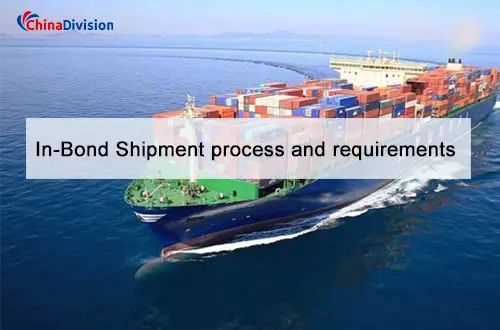What Are the in-bond Shipment Process and Requirements?
Cross-border transportation of goods often faces pain points such as tariffs, customs clearance delays, and high inventory costs. For sellers who need to postpone paying tariffs or clear customs in batches, bonded shipment (In-Bond Shipment) provides a flexible and efficient solution.
Table of Contents
Have you ever faced such a dilemma?
High-value goods are piled up at customs, occupying a large amount of working capital?
Urgently transshipped goods miss the peak sales season due to customs clearance delays?
Special goods (such as samples, exhibits) cannot be flexibly circulated due to import restrictions?
This is the core value of bonded transportation (In-Bond Shipment)! As a fulfillment service provider deeply engaged in international logistics, ChinaDivision will combine the practical experience of bonded logistics (Bond Logistics) to dismantle the process, advantages and common problems of this model for you to help you optimize supply chain management.
What is bonded shipment (In-Bond Shipment)?
Bonded shipment refers to a mode of transportation in which goods are directly transferred to a bonded warehouse, export processing zone or other designated location after entering the country of import without paying customs duties, and then the customs clearance procedures are completed after the final destination or purpose is determined. The goods are in "bonded status (In-Bond Status)" during this process, which is equivalent to enjoying "temporary tax exemption" treatment under customs supervision.

Bonded transportation (In-Bond Shipment / Shipping in Bond) refers to a special logistics mode in which goods are transported from one customs point to another customs point (such as port to bonded warehouse) or the final customs clearance location under customs supervision, with customs duties and taxes temporarily deferred. The goods are in bonded status (In-Bond Status) throughout the process.
This mode is suitable for:
International goods that need to be transferred (in-bond transit)
Goods planned for subsequent export (in-bond export)
Imported goods that need to be temporarily stored (bonded inventory)
Why choose bonded transportation?
Delay tax payment and optimize cash flow
Duties do not need to be paid immediately when goods enter the country, but only at the final customs clearance. For sellers with slow inventory turnover or who need to sell in batches, it can significantly reduce capital occupation.
Avoid customs clearance delays
If the destination or purpose of the goods is uncertain (such as for sale, re-export or repair), the bonded mode can avoid customs clearance detention due to incomplete information and shorten the transportation cycle. The "bonded transit" mode allows goods to be quickly transferred to a better customs clearance point or distribution center to avoid congestion at the port of entry, which is particularly suitable for sellers with multi-national business layouts.
Flexible inventory allocation and reduced storage costs
Bonded warehouses allow goods to be temporarily stored for several years, and sellers can dynamically adjust sales strategies according to market demand to reduce the risk of unsalable goods.
Break through restrictions and expand business opportunities
Handle samples that do not meet the final import conditions (such as lack of licenses), need domestic display/inspection, or goods with undetermined destinations. Provide compliance solutions for your special business scenarios.
Full analysis of the bonded transportation process: from entry to customs clearance
Goods entry declaration
The shipper submits In-Bond Entry to the customs, stating that the goods are not subject to tax for the time being, and provides information on the bonded warehouse or transshipment destination.
Customs review and release
After the customs verifies the documents (such as bills of lading, commercial invoices, and bonded guarantee letters), it assigns an In-Bond number to the goods and allows them to be transshipped to a designated location.
Bonded warehousing or transshipment
Goods can be stored in bonded warehouses or transported to other bonded areas (such as export processing zones) by trucks, railways, etc., and are subject to customs supervision throughout the process.
Final customs clearance or transshipment export
Domestic sales: Submit the final consignee information and tariff payment certificate to complete customs clearance.
Transshipment trade: Transship goods to a third country without paying import tariffs throughout the process.
When the goods arrive at the bonded warehouse (Bonded Inventory/Warehouse) of the designated destination, the customs verifies the seal and status, and then the goods are put into storage. The goods are finally cleared (officially imported after paying tariffs) or the next bonded operation (such as processing, transshipment) is carried out.
Overdue processing
If the goods are not cleared or transshipped within the specified time (usually 6 months), late payment fees must be paid or they will be auctioned by the customs.
Key requirements and sellers’ notes
Compliance documents are the basis: accurate and complete commercial invoices, packing lists, and transportation documents (bill of lading/waybill) are essential.
Choose a reliable carrier: The carrier (such as Chinadivision) must have the qualifications and experience to handle bonded logistics (Bond Logistics/Bonding Logistics) and assume compliance responsibilities during transportation.
Designated bonded facilities: The destination must be a bonded warehouse or port approved by the customs.
Strict time limit: Customs of various countries have clear time requirements for bonded transportation status (such as the United States, usually 15-30 days), and overdue will face fines or goods disposal risks.
Common questions from sellers about In-Bond Shipping
What does the bonded fee include?
Basic costs: bonded warehouse rental, cargo loading and unloading fees, customs supervision fees.
Additional costs: overstay fees, transshipment transportation fees, customs clearance agency fees.
Hidden costs: If the process is not standardized and leads to customs inspection, additional fines may be incurred.
What goods are suitable for bonded transportation?
Generally speaking, a wide range of goods can be transported in bonded transport. However, dangerous goods, controlled substances or other controlled items are subject to certain restrictions.
How to choose a reliable bonded logistics service provider?
Qualifications: Customs AEO certification and bonded warehouse operation qualifications are required.
Network: Bonded warehouses and transshipment channels covering major trading countries.
Technology: Provide real-time inventory tracking and customs clearance status updates.
ChinaDivision advantages: It has a global bonded warehouse network and supports multilingual customer service and digital system docking.
What if bonded transportation fails (such as being detained by customs)?
Common reasons include missing documents, goods not matching the declaration or overstaying.
Will bonded transportation be slower than general sea/air customs clearance?
No! Its core value lies in process optimization. For goods that need to be transshipped or temporarily deferred for customs clearance, it avoids congestion and repeated inspections at the port of entry, and instead accelerates the overall logistics flow.
Is bonded transportation suitable for sellers on e-commerce platforms?
Yes, it is especially suitable for cross-border sellers on platforms such as Amazon FBA, Shopify, and eBay, which can realize operations such as overseas warehouse replenishment, return and re-export.
Chinadivision: Your professional bonded logistics partner
Faced with a complex bonded logistics (Bond Logistics) network, you don't have to fight alone. As an international logistics fulfillment and third-party logistics (3PL) expert, Chinadivision provides a one-stop solution:
Expert customs team: Proficient in the bonded rules of major global markets (such as China, the United States, and Europe), ensuring accurate and compliant declarations.
Seamless transportation network: Integrate sea, air, land and bonded warehousing resources to provide door-to-door bonded transportation services.
Intelligent technology empowerment: Advanced logistics management system realizes full process visualization and automatic early warning, allowing you to strategize.
Customized solutions: Design the most cost-effective bonded transportation route based on your cargo volume, product characteristics, and target market.
Bonded shipment is a "buffer zone" in international logistics, providing sellers with a flexible tool to deal with uncertainty. Whether you are just starting to explore bonded transportation or want to optimize existing processes, Chinadivision's professional team is happy to provide you with free consultation and customized solutions. Unleash your capital liquidity and make cross-border logistics smarter and more efficient! Choose ChinaDivision to find the best balance between compliance and efficiency for your goods!





